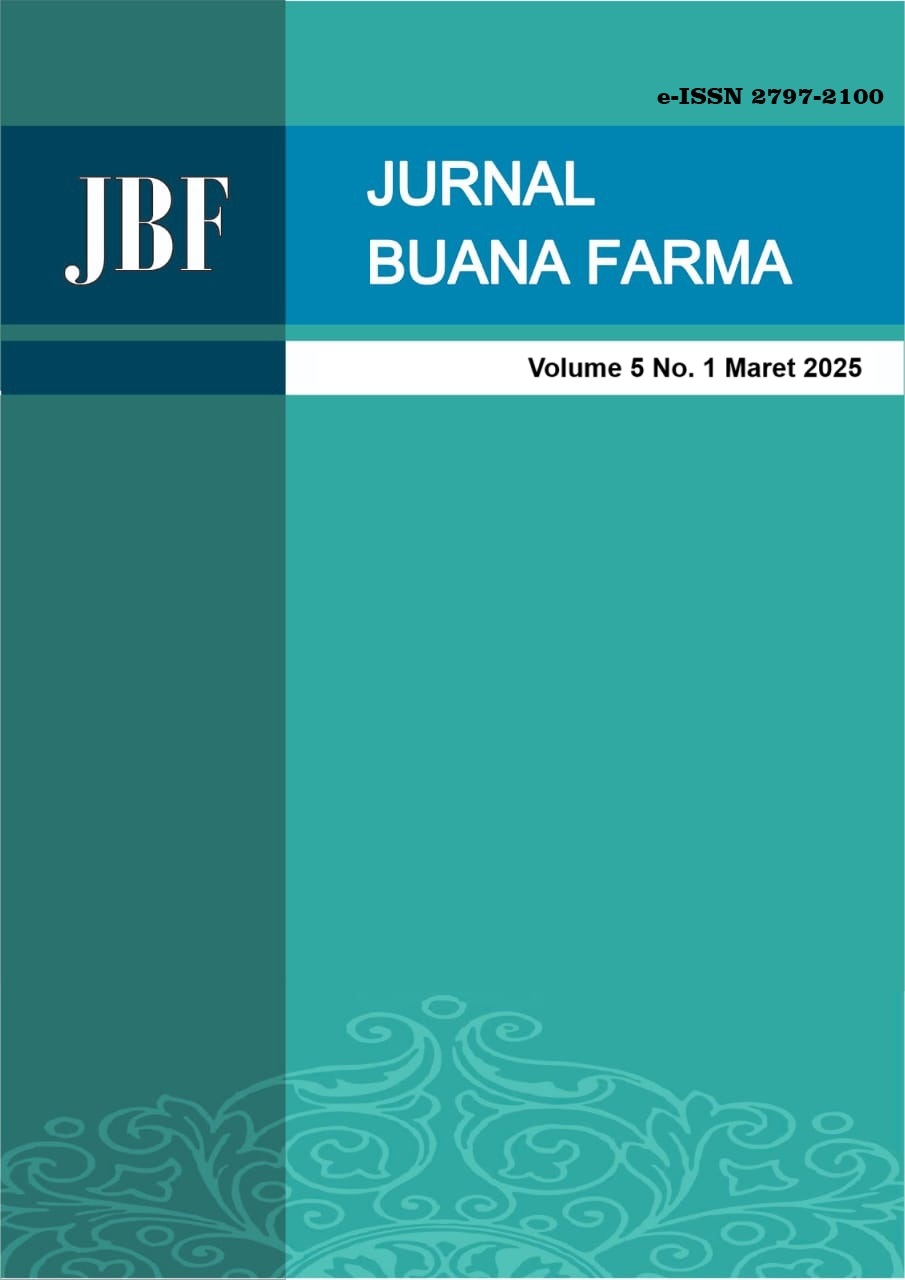EFEK ANTIMIKROBA EKSTRAK Arcangelisia flava, Curcuma longa, Curcuma zanthorrhiza TERHADAP Bacillus DAN Pseudomonas PENYEBAB DIARE
Abstract
Diarrhea is a major health issue often caused by Bacillus sp. and Pseudomonas aeruginosa. This study aims to evaluate the antibacterial activity of a combination of Arcangelisia flava, Curcuma longa, and Curcuma zanthorrhiza extracts against these bacteria. The research was conducted in vitro using a Completely Randomized Design (CRD) with extract concentrations of 30%, 50%, 75%, and 100%, along with positive and negative controls. Antibacterial tests were carried out using the disk diffusion method to measure the inhibition zones after 24, 48, and 72 hours of incubation. The results showed the highest inhibition zones at 100% concentration, reaching 1.38 mm for Bacillus sp. and 1.33 mm for Pseudomonas aeruginosa after 72 hours. This antibacterial activity is supported by active compounds such as flavonoids, alkaloids, and curcumin. In conclusion the combination of these extracts effectively inhibits diarrhea-causing bacteria and has potential as a safe herbal alternative to address antibiotic resistance.
References
Agusti, N. M., & Aslam, A. (2022). Efektivitas Media Pembelajaran Aplikasi Wordwall Terhadap Hasil Belajar IPA Siswa Sekolah Dasar. Jurnal Basicedu, 6(4):5794–5800.
Anggraeni, V. J., Kurnia, D., Djuanda, D., & Mardiyani, S. (2023). Komposisi Kimia dan Penentuan Senyawa Aktif Antioksidan dari Minyak Atsiri Kunyit (Curcuma longa L.). Jurnal Farmasi Higea, 15(1):54.
Astuti, L. A., Muslichah, D. A., Suprihadi, A., Rukmi, M. I., Mulyani, N., & Sutisna, E. (2021). Karakterisasi Bakteri Diazotrof dan Pengaruhnya Terhadap Pertumbuhan Tanaman Kedelai (Gylycine max L. Merrill). NICHE Journal of Tropical Biology, 4(1):40–49.
Hujjatusnaini, N. (n.d.). Uji Potensi Ekstrak Daun Ketepeng Cina (Cassia alata L.) Terhadap Penghambatan Pertumbuhan Trichophyton sp. 1–17.
Hujjatusnaini, N., Amin, A. M., Febrianty, R., Maisyarah, A., Agriana, B. M., Septianingru, D. D., Maradona, Wulandari, N. S., & Maryam, S. (2022). Jurnal Biology Science & Education 2022 Muhammad rijal. Njural Biology Science & Education, 11(1):31–44.
Hujjatusnaini, N., Friska, Y. D., Saadah, A., & Muh. Amin, A. (2021). The Potential Of Purple Leaves Ethanol Extract (Graptophyllum pictum L.) Against The Growth Of Staphylococcus aureus and Candida albicans. Jurnal Agronomi Tanaman Tropika (Juatika), 3(2):196–207.
Hujjatusnaini, N., Nirmalasari, R., Amin, A. M., & Fadillah, A. Z. (n.d.). Kecenderungan Sifat Antimikroba Kombinasi Artocarpus altilis dan Molinda citrifolia Terhadap Klebsiella pnumoniae dan Malassezia furfur. 45–59.
Hujjatusnaini, N., Nirmalasari, R., Amin, A. M., Nur, J. B., Siammukaromah, Fatimah, Alia, R., Meiana, N. A., Puteri, S., Maharani, & Wahyuni, S. (2024). Perbandingan Sifat Fungistastik Efektif Antara Ekstrak Daun Muntingia calabura DAN Strobilanthes crispa Terhadap Fusarium sp Secara In Vitro. Jurnal Insan Farmasi Indonesia, 7(1):135–145.
Indonesia, K. K. R. (2021). Laporan Situasi Kesehatan Masyarakat Indonesia 2021. Kementerian Kesehatan RI.
Kumalasari, M. L. F., & Andiarna, F. (2020). Uji Fitokimia Ekstrak Etanol Daun Kemangi (Ocimum basilicum L). Indonesian Journal for Health Sciences, 4(1):39.
Meitania Utami, S., Permata Sari, D., Adi Ismaya, N., Herdiawan STIKes Widya Dharma Husada Tangerang, E., Pajajaran No, J., & Selatan, T. (2022). Review Artikel Aktivitas Antibakteri Ekstrak Rimpang Kunyit (Curcuma domestica Val) Terhadap Beberapa Sempel Bakteri. PHRASE (Pharmaceutical Science) Journal, 2(2):90–98.
Ningsih, I. S., Charti, M., Advinda, L., & Violita. (2023). Flavonoid Active Compounds Found In Plants Senyawa Aktif Flavonoid yang Terdapat Pada Tumbuhan. Serambi Biologi, 8(2):126.
Ningtyas, A. F. (2015). Uji potensi antibakteri dan uji keberadaan enzim squalene sintase bakteri endofit rimpang temulawak (Curcuma xanthorrhiza Roxb.). Skripsi, 6–7.
Putu, N., Cipta, A., Jelantik, R., & Cahyaningsih, E. (2022). Antioxidant potential of telang flowers ( Clitoria ternatea L .) as an inhibitor of hyperpigmentation due to ultraviolet exposure Potensi antioksidan bunga telang ( Clitoria ternatea L .) sebagai penghambat hiperpigmentasi akibat paparan sinar ultraviolet. 45–54.
Ramadhani, R., Nurdian, Y., Rachmawati, D. A., Utami, W. S., Armiyanti, Y., Hermansyah, B., & Rahardjo, A. M. (2022). Stall Sanitation Associated with Cryptosporidium sp. Infection on Calf and Cattle Farmer. Jurnal Medik Veteriner, 5(2):178–187.
Santoso, J. A. (2018). Selection of Stenochlaena palustris Extracts Based on Alpha-Glucosidase Inhibitory Activities. 15, 1–8.
Suryani, Y., Hernaman, I., & Ningsih, N. (2017). Pengaruh Penambahan Urea Dan Sulfur Pada Limbah Padat Bioetanol Yang Difermentasi Em-4 Terhadap Kandungan Protein Dan Serat Kasar. Jurnal Ilmiah Peternakan Terpadu, 5(1):13.
Syamsudin, R. A. M. R., Perdana, F., Suci Mutiaz, F., Galuh, V., Putri Ayu Rina, A., Dwi Cahyani, N., Aprilya, S., Yanti, R., & Khendri, F. (2019). Temulawak Plant (Curcuma xanthorrhiza Roxb) as a Traditional Mmedicine. Jurnal Ilmiah Farmako Bahari, 10(1):51–65.
Torar, G. M. J., Lolo, W. A., & Citraningtyas, G. (2017). Uji Aktivitas Antibakteri Ekstrak Etanol Biji Pepaya (Carica papaya L.) Terhadap Bakteri Pseudomonas aeruginosa Dan Staphylococcus aureus. PHARMACON: Jurnal Ilmiah Farmasi-UNSRAT, 6(2):14–22.
Wardoyo, E. H., Hasbi, N., Rahim, A. R., Arnawati, I. A., Haza, S. S., Hulfifa, L. N., Dwi, A., Firdaus, C., & Satya, I. K. (n.d.). Aktivitas Propolis Madu Putih Sumbawa Terhadap Pertumbuhan Staphylococcus epidermidis , Staphylococcus aureus dan Escherichia coli. 12(1), 33–39.
Widi, R. K. (2006). Penjaringan dan Identifikasi Senyawa Alkaloid dalam Batang Kayu Kuning (Arcangelisia Flava Merr) (Screening and Identification of Alkaloid Compounds in Kayu Kuning Stem ( Arcangelisia Flava Merr)). Jurnal Ilmu Dasar, 8(1):24–29.
Widyastuti, R., Hujjatusnaini, N., Septiana, N., & Amin, A. M. (2021). Antimicrobial Potential Combination Formulation of 1:2:3 Methanol Extract of Tambora Leaf (Ageratum conyzoides L), Sembalit Angin Leaf (Mussaenda frondosa L), and Turmeric Rhizome (Curcuma longa) Against Escherichia coli. Sainstek : Jurnal Sains Dan Teknologi, 13(2):121.
Yuliati, Y. (2017). Uji Efektifitas Ekstrak Kunyit Sebagai Antibakteri Dalam Pertumbuhan Bacillus sp dan Shigella dysentriae Secara In Vitro. Jurnal Profesi Medika : Jurnal Kedokteran Dan Kesehatan, 10(1).
Yurseli. (2018). Penggunaan Beberapa Metode Ekstraksi Pada Rimpang Curcuma Untuk Memperoleh Komponen Aktif Secara Kualitatif. 3(2):91–102.













